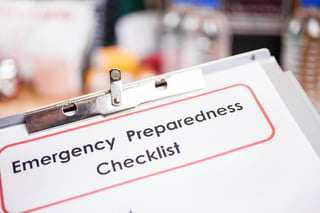November 13, 2017 | Peter Corless
November 13, 2017 | Peter Corless
 The Emergency Preparedness Requirements for Medicare and Medicaid Participating Providers and Suppliers rule will be enforceable as of Wednesday, November 15, 2017. This rule, announced last September by the Centers for Medicare & Medicaid Services, requires that all CMS providers and suppliers submit their emergency preparedness plan.
The Emergency Preparedness Requirements for Medicare and Medicaid Participating Providers and Suppliers rule will be enforceable as of Wednesday, November 15, 2017. This rule, announced last September by the Centers for Medicare & Medicaid Services, requires that all CMS providers and suppliers submit their emergency preparedness plan.
While the majority of long-term care providers already allocate significant resources for emergency preparedness, the aftermath of the numerous severe weather events of the past year make these requirements of a documented plan timelier than ever.
In order to be compliant with the rule, CMS has outlined four core elements for an Effective Emergency Preparedness Framework that providers must include in their plan—including an emergency plan, policies and procedures, a communications plan, as well as training and testing procedures.
During widespread emergencies, having an established communication plan is vital to providing the best care for your residents. In order to be considered compliant, your emergency communication plan must be compliant with federal and state regulations. This, combined with the following best practices, can help ensure your communication plan is as effective as possible:
Every employee will play a role in your emergency preparedness plan, so it’s important to establish a clear chain of command to ensure that the plan is rolled out as smoothly as possible. This includes defining clear roles and responsibilities for communicating with staff during an emergency.
Make sure your communication plan has a clear outline of who needs to be contacted the moment an emergency hits and who is responsible for ensuring every employee is made aware of his or her role in the appropriate manner.
Having this clearly defined up front can help avoid confusion and ensure that everyone has the information they need, when they need it.
It’s not enough to just rely on a single mode of communication for reaching your employees in the event of an emergency. In other words, you don’t want to just call down a phone list—since phone lines could be down—or just send a mass text since cellular signals could be affected.
That’s why it’s important for long-term care providers to have a multimodal communication system in place, i.e. a communication platform that allows them to send a single message to their staff via a variety of communication modes all at once.
Being properly staffed is the most important factor in providing high quality care. And in the event of an emergency, having the right people, in the right place, at the right time becomes even more important. That’s why OnShift’s messaging tools give providers the ability to instantly send a single message to all employees and, in the event of an emergency, allows them to send that message through multiple mediums, including an automated phone call, text, email or push notification through the OnShift mobile app.
With technology like OnShift in place, providers can clearly communicate expectations for their employees based on their preferred communication method and reinforce policies and procedures that need to take place to ensure the safety and well-being of their residents.
To make sure your staff can recognize urgent messages in an instant, it’s important that you regularly test your emergency communication system. At OnShift, we recommend clients test the use of sending an emergency message to their staff once per month. This test can be as simple as sending a test message and asking staff to reply Yes or No to the message.
These regular tests also allow you to easily see who is properly enrolled in your communication system. In other words, if they have a valid form of communication, whether that’s an email address or a phone number.
If you have an employee who doesn’t reply to your test message, it’s important to follow-up with them to ensure you have the right information to contact them in the event of emergency. And if response rates are low overall, this could signal a potential training opportunity for employees to make sure they understand the importance of being prepared in the event of an emergency.
To learn more about creating an Effective Emergency Preparedness Framework, visit the Centers for Medicare and Medicaid website for more questions on developing your emergency communications plan for your long-term care organization.
Subscribe to the OnShift Blog
Recent Posts
Categories
About Peter Corless
Peter Corless is Executive Vice President of Enterprise Development for OnShift. Peter is a recognized HR leader in post-acute care and is well-known for his achievements at some of the country’s largest post-acute care organizations, including Kindred Healthcare and Genesis HealthCare. As an experienced, chief administrative and human resources officer within these organizations, he developed strategies that reduced turnover, improved recruiting and hiring strategies, and reduced labor costs.
See for yourself why thousands of providers rely on OnShift’s innovative software for recruitment, hiring, workforce management, pay and engagement. Request your personalized demo today.
